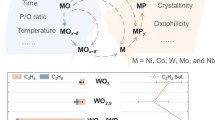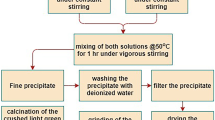Abstract
A novel method for the synthesis of nanocrystalline neodymium-doped yttria (Nd:Y2O3) by gel combustion in microwave without long period of calcination at high temperature is described. The method leads to rapid formation of phase pure product with saving of time and energy. Gels were prepared by selecting citrate to nitrate (C/N) ratios of 0.5:1 & 1:1 followed by combustion in microwave for drying of gel leading to precursor formation. Thermogravimetric-differential thermal analysis (TG-DTA) of precursor with (C/N) ratios of 1:1 exhibited a total loss in weight of about 31.7% up to 1300 °C and did not show M–O bonds characteristic of yttria by FTIR indicating requirement of calcination at high temperature. Crystallization to phase pure yttria took place only on thermal treatment at 1000 °C for 4 h in oxygen atmosphere confirmed by XRD with particle size 40 nm. While the microwave combusted precursor with C/N ratio of 0.5:1 exhibited a weight loss of only 4.7% up to 1300 °C and showed M–O bonds characteristic of yttria in FTIR spectrum without calcinations at higher temperature. This microwave combustion precursor with C/N ratio of 0.5:1 was found to be crystalline phase pure yttria by X-ray diffraction (XRD) with primary particle size 28 nm by Scherrer’s equation and 30–50 nm of uniform morphology by transmission electron microscopy (TEM). In the present work the ratio of citric acid to nitrates is playing a crucial role in terms of saving time and energy involved in calcinations of microwave combusted precursor for the composition with higher citrate content.








Similar content being viewed by others
References
Fokema MD, Chiu E, Ying JY (2000) Langmuir 16(7):3154
Tomaszewski H, Weglarz H, De Gryse R (1997) J Eur Ceram Soc 17:403
Akinc M, Celikkaya A (1987) Advances in ceramics. Inc. Press, Westerville, OH
Rulison AJ, Flagan RC (1994) J Am Ceram Soc 77:3244
Dupont A, Parent C, Garrecand BL, Heintz JM (2003) J Solid State Chem 171(1–2):152
Mouzon J, Odén M (2007) Powder Tech 177(2):77
Ekambaram S, Patil KC (1995) J Mater Chem 5:905
Kakade B, Ramanathan S, Ravindran PV (2003) J Alloys Compd 350(1–2):123
Rahamana MN (2003) Ceramic processing and sintering, 2nd edn. CRC Press, London
Bondioli F, Ferrari AM, Leonelli C, Siligardi C et al (2001) J Mater Chem 11:2620
Nyutu EK, Chen CH, Sithambaram S et al (2008) J Phys Chem C 112(17):6786
Manglaraja RV, Ramam KVS et al (2007) Mater Sci Pol 25(4):1075
Panneer SM, Subanna GN, Rao KJ (2001) J Mater Res 16(10):2773
Subramanian V, Burke WW, Zhu H, Wei B (2008) J Phys Chem C 112(12):4550
Vishnuvardhan TK, Kulkarni VR, Basavaraja C, Raghavendra SC (2006) Bull Mater Sci 29(1):77
da Vila LD, Stucchi EB, Davolos MR (1997) J Mater Chem 7(10):2113
Culity BD, Stock SR (1978) Elements of X-ray diffraction. Addison, Wesley, MA
Bartos A et al (1993) Acta Crystallogr B Struct Sci 49:165
Kaygorodov AS, Ivanov VV et al (2007) J Eur Ceram Soc 27(2–3):1165
Acknowledgements
We would like to thank Director, Laser Science and Technology Centre, Defence Research and Development Organization (DRDO), Delhi, for the encouragement and support to carry out this work. Further we extend our thanks to Dr. Prasoon Roy, Scientist ‘D’, Centre for Fire, Explosive and Environment, and Mr. Anshu, Scientist ‘B’, Solid State Physics Laboratory, DRDO, Delhi, for their timely help during various characterizations.
Author information
Authors and Affiliations
Corresponding author
Rights and permissions
About this article
Cite this article
Rekha, M., Laishram, K., Gupta, R.K. et al. Energy-efficient green synthesis of Nd:Y2O3 nanopowder by microwave gel combustion. J Mater Sci 44, 4252–4257 (2009). https://doi.org/10.1007/s10853-009-3615-4
Received:
Accepted:
Published:
Issue Date:
DOI: https://doi.org/10.1007/s10853-009-3615-4




